Recent Progress of Switching Power Management for Triboelectric Nanogenerators
Abstract
:1. Introduction
2. Fundamentals of Switching Power Management for TENG
2.1. The V-Q-x Relationship for TENGs
2.2. Output Characteristics under Resistive Load
2.3. Charging Characteristics under Capacitive Load
2.4. The V-Q Curve for TENG
3. Power Management with Mechanical Switch
3.1. Travel Switch
3.1.1. Series Switch
3.1.2. Parallel Switch
3.1.3. Switch Capacitor Convertor
3.2. Voltage-Triggered Switch
3.2.1. Spark Switch
3.2.2. Electrostatic Switch
4. Power Management with Electronic Switch
4.1. Discrete Transistor Switch
4.1.1. Silicon-Controlled Rectifier
4.1.2. MOSFET
4.2. Integrated Circuit
5. Conclusions and Prospects
Author Contributions
Funding
Institutional Review Board Statement
Informed Consent Statement
Data Availability Statement
Conflicts of Interest
References
- Gershenfeld, N.; Krikorian, R.; Cohen, D. The Internet of Things. Sci. Am. 2004, 291, 76–81. [Google Scholar] [CrossRef] [PubMed]
- Agiwal, M.; Roy, A.; Saxena, N. Next generation 5G wireless networks: A comprehensive survey. IEEE Commun. Surv. Tutor. 2016, 18, 1617–1655. [Google Scholar] [CrossRef]
- Akyildiz, I.F.; Su, W.; Sankarasubramaniam, Y.; Cayirci, E. Wireless sensor networks: A survey. Comput. Netw. 2002, 38, 393–422. [Google Scholar] [CrossRef] [Green Version]
- Wang, Z.L. Entropy theory of distributed energy for internet of things. Nano Energy 2019, 58, 669–672. [Google Scholar] [CrossRef]
- Liu, G.; Yu, Y.; Hou, J.; Xue, W.; Liu, X.; Liu, Y.; Wang, W.; Alsaedi, A.; Hayat, T.; Liu, Z. An ecological risk assessment of heavy metal pollution of the agricultural ecosystem near a lead-acid battery factory. Ecol. Indic. 2014, 47, 210–218. [Google Scholar] [CrossRef]
- Fonash, S. Solar Cell Device Physics; Elsevier: Amsterdam, The Netherlands, 2012. [Google Scholar]
- Zhang, L.B.; Dai, H.L.; Abdelkefi, A.; Lin, S.X.; Wang, L. Theoretical modeling, wind tunnel measurements, and realistic environment testing of galloping-based electromagnetic energy harvesters. Appl. Energ. 2019, 254, 113737. [Google Scholar] [CrossRef]
- Zhou, Z.; Qin, W.; Zhu, P.; Du, W.; Deng, W.; Pan, J. Scavenging wind energy by a dynamic-stable flutter energy harvester with rectangular wing. Appl. Phys. Lett. 2019, 114, 243902. [Google Scholar] [CrossRef]
- Fu, X.; Bu, T.; Li, C.; Liu, G.; Zhang, C. Overview of micro/nano-wind energy harvesters and sensors. Nanoscale 2020, 12, 23929–23944. [Google Scholar] [CrossRef] [PubMed]
- Kim, S.; Choi, S.J.; Zhao, K.; Yang, H.; Gobbi, G.; Zhang, S.; Li, J. Electrochemically driven mechanical energy harvesting. Nat. Commun. 2016, 7, 10146. [Google Scholar] [CrossRef] [PubMed] [Green Version]
- Maxwell, J. A Treatise On Electricity and Magnetism. Nature 2014, 7, 478–480. [Google Scholar]
- Zou, H.; Dai, G.; Wang, A.C.; Li, X.; Zhang, S.L.; Ding, W.; Zhang, L.; Zhang, Y.; Wang, Z.L. Alternating current photovoltaic effect. Adv. Mater. 2020, 32, 1907249. [Google Scholar] [CrossRef] [PubMed]
- Der Wissenschaften Zu Berlin, K.A. Abhandlungen der Königlichen Akademie der Wissenschaften zu Berlin; Georg Reimer: Bayern, Germany, 1825. [Google Scholar]
- Arnau, A.; Soares, D. Fundamentals of piezoelectricity. In Piezoelectric Transducers and Applications; Springer: New York, NY, USA, 2009; pp. 1–38. [Google Scholar]
- He, K.; Xin, H.L.; Zhao, K.; Yu, X.; Nordlund, D.; Weng, T.; Li, J.; Jiang, Y.; Cadigan, C.A.; Richards, R.M. Transitions from near-surface to interior redox upon lithiation in conversion electrode materials. Nano Lett. 2015, 15, 1437–1444. [Google Scholar] [CrossRef]
- Wang, S.; Lin, L.; Wang, Z.L. Nanoscale triboelectric-effect-enabled energy conversion for sustainably powering portable electronics. Nano Lett. 2012, 12, 6339–6346. [Google Scholar] [CrossRef] [PubMed] [Green Version]
- Zhu, G.; Pan, C.; Guo, W.; Chen, C.; Zhou, Y.; Yu, R.; Wang, Z.L. Triboelectric-generator-driven pulse electrodeposition for micropatterning. Nano Lett. 2012, 12, 4960–4965. [Google Scholar] [CrossRef]
- Chen, C.; Guo, H.; Chen, L.; Wang, Y.; Pu, X.; Yu, W.; Wang, F.; Du, Z.; Wang, Z.L. Direct current fabric triboelectric nanogenerator for biomotion energy harvesting. ACS Nano 2020, 14, 4585–4594. [Google Scholar] [CrossRef]
- Dong, K.; Deng, J.; Ding, W.; Wang, A.C.; Wang, P.; Cheng, C.; Wang, Y.C.; Jin, L.; Gu, B.; Sun, B. Versatile core–sheath yarn for sustainable biomechanical energy harvesting and real-time human-interactive sensing. Adv. Energy Mater. 2018, 8, 1801114. [Google Scholar] [CrossRef]
- Padhan, A.M.; Hajra, S.; Nayak, S.; Kumar, J.; Sahu, M.; Kim, H.J.; Alagarsamy, P. Triboelectrification based on NiO-Mg magnetic nanocomposite: Synthesis, device fabrication, and energy harvesting performance. Nano Energy 2022, 91, 106662. [Google Scholar] [CrossRef]
- Jiang, D.; Liu, G.; Li, W.; Bu, T.; Wang, Y.; Zhang, Z.; Pang, Y.; Xu, S.; Yang, H.; Zhang, C. A leaf-shaped triboelectric nanogenerator for multiple ambient mechanical energy harvesting. IEEE Trans. Power Electr. 2019, 35, 25–32. [Google Scholar] [CrossRef]
- Liang, Q.; Yan, X.; Liao, X.; Zhang, Y. Integrated multi-unit transparent triboelectric nanogenerator harvesting rain power for driving electronics. Nano Energy 2016, 25, 18–25. [Google Scholar] [CrossRef]
- Xu, W.; Zheng, H.; Liu, Y.; Zhou, X.; Zhang, C.; Song, Y.; Deng, X.; Leung, M.; Yang, Z.; Xu, R.X. A droplet-based electricity generator with high instantaneous power density. Nature 2020, 578, 392–396. [Google Scholar] [CrossRef]
- Liu, G.; Guo, H.; Xu, S.; Hu, C.; Wang, Z.L. Oblate spheroidal triboelectric nanogenerator for all-weather blue energy harvesting. Adv. Energy Mater. 2019, 9, 1900801. [Google Scholar] [CrossRef]
- Liu, G.; Xiao, L.; Chen, C.; Liu, W.; Pu, X.; Wu, Z.; Hu, C.; Wang, Z.L. Power cables for triboelectric nanogenerator networks for large-scale blue energy harvesting. Nano Energy 2020, 75, 104975. [Google Scholar] [CrossRef]
- Liu, W.; Xu, L.; Bu, T.; Yang, H.; Liu, G.; Li, W.; Pang, Y.; Hu, C.; Zhang, C.; Cheng, T. Torus structured triboelectric nanogenerator array for water wave energy harvesting. Nano Energy 2019, 58, 499–507. [Google Scholar] [CrossRef]
- Chen, S.; Wang, N.; Ma, L.; Li, T.; Willander, M.; Jie, Y.; Cao, X.; Wang, Z.L. Triboelectric nanogenerator for sustainable wastewater treatment via a self-powered electrochemical process. Adv. Energy Mater. 2016, 6, 1501778. [Google Scholar] [CrossRef]
- Sahu, M.; Hajra, S.; Kim, H.; Rubahn, H.; Mishra, Y.K.; Kim, H.J. Additive manufacturing-based recycling of laboratory waste into energy harvesting device for self-powered applications. Nano Energy 2021, 88, 106255. [Google Scholar] [CrossRef]
- Liang, F.; Chao, X.; Yu, S.; Gu, Y.; Zhang, X.; Wei, X.; Fan, J.; Tao, X.; Shou, D. An all-fabric droplet-based energy harvester with topology optimization. Adv. Energy Mater. 2021, 2102991. [Google Scholar] [CrossRef]
- Zhao, J.; Zhen, G.; Liu, G.; Bu, T.; Liu, W.; Fu, X.; Zhang, P.; Zhang, C.; Wang, Z.L. Remarkable merits of triboelectric nanogenerator than electromagnetic generator for harvesting small-amplitude mechanical energy. Nano Energy 2019, 61, 111–118. [Google Scholar] [CrossRef]
- Zhang, C.; Tang, W.; Han, C.; Fan, F.; Wang, Z.L. Theoretical comparison, equivalent transformation, and conjunction operations of electromagnetic induction generator and triboelectric nanogenerator for harvesting mechanical energy. Adv. Mater. 2014, 26, 3580–3591. [Google Scholar] [CrossRef] [PubMed]
- Xu, S.; Fu, X.; Liu, G.; Tong, T.; Bu, T.; Wang, Z.L.; Zhang, C. Comparison of applied torque and energy conversion efficiency between rotational triboelectric nanogenerator and electromagnetic generator. iScience 2021, 24, 102318. [Google Scholar] [CrossRef] [PubMed]
- Niu, S.; Wang, Z.L. Theoretical systems of triboelectric nanogenerators. Nano Energy 2015, 14, 161–192. [Google Scholar] [CrossRef] [Green Version]
- Niu, S.; Liu, Y.; Wang, S.; Lin, L.; Zhou, Y.S.; Hu, Y.; Wang, Z.L. Theory of sliding-mode triboelectric nanogenerators. Adv. Mater. 2013, 25, 6184–6193. [Google Scholar] [CrossRef]
- Niu, S.; Wang, S.; Lin, L.; Liu, Y.; Zhou, Y.S.; Hu, Y.; Wang, Z.L. Theoretical study of contact-mode triboelectric nanogenerators as an effective power source. Energ. Environ. Sci. 2013, 6, 3576. [Google Scholar] [CrossRef]
- Niu, S.; Liu, Y.; Wang, S.; Lin, L.; Zhou, Y.S.; Hu, Y.; Wang, Z.L. Theoretical investigation and structural optimization of single-electrode triboelectric nanogenerators. Adv. Funct. Mater. 2014, 24, 3332–3340. [Google Scholar] [CrossRef]
- Niu, S.; Zhou, Y.S.; Wang, S.; Liu, Y.; Lin, L.; Bando, Y.; Wang, Z.L. Simulation method for optimizing the performance of an integrated triboelectric nanogenerator energy harvesting system. Nano Energy 2014, 8, 150–156. [Google Scholar] [CrossRef]
- Niu, S.; Liu, Y.; Chen, X.; Wang, S.; Zhou, Y.S.; Lin, L.; Xie, Y.; Wang, Z.L. Theory of freestanding triboelectric-layer-based nanogenerators. Nano Energy 2015, 12, 760–774. [Google Scholar] [CrossRef] [Green Version]
- Niu, S.; Liu, Y.; Zhou, Y.S.; Wang, S.; Lin, L.; Wang, Z.L. Optimization of Triboelectric Nanogenerator Charging Systems for Efficient Energy Harvesting and Storage. IEEE Trans. Electron. Dev. 2015, 62, 641–647. [Google Scholar]
- Bao, D.; Luo, L.; Zhang, Z.; Ren, T. A power management circuit with 50% efficiency and large load capacity for triboelectric nanogenerator. J. Semicond. 2017, 38, 95001. [Google Scholar] [CrossRef]
- Zhang, H.; Galayko, D.; Basset, P. A self-sustained energy storage system with an electrostatic automatic switch and a buck converter for triboelectric nanogenerators. J. Phys. Conf. Ser. 2019, 1407, 12016. [Google Scholar] [CrossRef]
- Qin, H.; Gu, G.; Shang, W.; Luo, H.; Zhang, W.; Cui, P.; Zhang, B.; Guo, J.; Cheng, G.; Du, Z. A universal and passive power management circuit with high efficiency for pulsed triboelectric nanogenerator. Nano Energy 2020, 68, 104372. [Google Scholar] [CrossRef]
- Xu, S.; Ding, W.; Guo, H.; Wang, X.; Wang, Z.L. Boost the performance of triboelectric nanogenerators through circuit oscillation. Adv. Energy Mater. 2019, 9, 1900772. [Google Scholar] [CrossRef]
- Cheng, G.; Lin, Z.; Du, Z.; Wang, Z.L. Increase output energy and operation frequency of a triboelectric nanogenerator by two grounded electrodes approach. Adv. Funct. Mater. 2014, 24, 2892–2898. [Google Scholar] [CrossRef]
- Cao, Z.; Wang, S.; Bi, M.; Wu, Z.; Ye, X. Largely enhancing the output power and charging efficiency of electret generators using position-based auto-switch and passive power management module. Nano Energy 2019, 66, 104202. [Google Scholar] [CrossRef]
- Fang, C.; Tong, T.; Bu, T.; Cao, Y.; Xu, S.; Qi, Y.; Zhang, C. Overview of power management for triboelectric nanogenerators. Adv. Intell. Syst. 2020, 2, 1900129. [Google Scholar] [CrossRef]
- Xi, F.; Pang, Y.; Liu, G.; Wang, S.; Li, W.; Zhang, C.; Wang, Z.L. Self-powered intelligent buoy system by water wave energy for sustainable and autonomous wireless sensing and data transmission. Nano Energy 2019, 61, 1–9. [Google Scholar] [CrossRef]
- Liang, X.; Jiang, T.; Feng, Y.; Lu, P.; An, J.; Wang, Z.L. Triboelectric Nanogenerator Network Integrated with Charge Excitation Circuit for Effective Water Wave Energy Harvesting. Adv. Energy Mater. 2020, 10, 2002123. [Google Scholar] [CrossRef]
- Liang, X.; Jiang, T.; Liu, G.; Xiao, T.; Xu, L.; Li, W.; Xi, F.; Zhang, C.; Wang, Z.L. Triboelectric nanogenerator networks integrated with power management module for water wave energy harvesting. Adv. Funct. Mater. 2019, 29, 1807241. [Google Scholar] [CrossRef]
- Stanzione, S.; van Liempd, C.; Nabeto, M.; Yazicioglu, F.R.; Van Hoof, C. A 500 nW batteryless integrated electrostatic energy harvester interface based on a DC-DC converter with 60 V maximum input voltage and operating from 1 μW available power, including MPPT and cold start, 2015. In Proceedings of the 2015 IEEE International Solid-State Circuits Conference—(ISSCC) Digest of Technical Papers, San Francisco, CA, USA, 22–26 February 2015; pp. 1–3. [Google Scholar]
- Stanzione, S.; van Liempd, C.; van Schaijk, R.; Naito, Y.; Yazicioglu, F.; Van Hoof, C. A high voltage self-biased integrated DC-DC buck converter with fully analog MPPT algorithm for electrostatic energy harvesters. IEEE J. Solid St. Circ. 2013, 48, 3002–3010. [Google Scholar] [CrossRef]
- Perez, M.; Boisseau, S.; Geisler, M.; Despesse, G.; Reboud, J.L. A triboelectric wind turbine for small-scale energy harvesting. J. Physics. Conf. Ser. 2016, 773, 12118. [Google Scholar] [CrossRef]
- Li, X.; Sun, Y. An SSHI Rectifier for Triboelectric Energy Harvesting. IEEE Trans. Power Electr. 2020, 35, 3663–3678. [Google Scholar] [CrossRef]
- Wang, Z.; Tang, Q.; Shan, C.; Du, Y.; He, W.; Fu, S.; Li, G.; Liu, A.; Liu, W.; Hu, C. Giant performance improvement of triboelectric nanogenerator systems achieved by matched inductor design. Energ. Environ. Sci. 2021, 14, 6627–6637. [Google Scholar] [CrossRef]
- Pathak, M.; Kumar, R. Synchronous pre-biasing of triboelectric nanogenerator for enhanced energy extraction. arXiv 2021, arXiv:2105.10856. [Google Scholar]
- Harmon, W.; Guo, H.; Bamgboje, D.; Hu, T.; Wang, Z.L. Timing strategy for boosting energy extraction from triboelectric nanogenerators. Nano Energy 2021, 85, 105956. [Google Scholar] [CrossRef]
- Chandrarathna, S.C.; Graham, S.A.; Ali, M.; Yu, J.S.; Lee, J.W. An Efficient Power Management System Using Dynamically Configured Multiple Triboelectric Nanogenerators and Dual-Parameter Maximum Power Point Tracking. Adv. Energy Mater. 2021, 12, 2103249. [Google Scholar] [CrossRef]
- Stanzione, S.; van Liempd, C.; van Schaijk, R.; Naito, Y.; Yazicioglu, R.F.; Van Hoof, C. In A self-biased 5-to-60 V input voltage and 25-to-1600 µW integrated DC-DC buck converter with fully analog MPPT algorithm reaching up to 88% end-to-end efficiency. In Proceedings of the 2013 IEEE International Solid-State Circuits Conference—Digest of Technical Papers, ISSCC 2013, San Francisco, CA, USA, 17–21 February 2013; pp. 74–75. [Google Scholar]
- Cheng, G.; Lin, Z.; Lin, L.; Du, Z.; Wang, Z.L. Pulsed Nanogenerator with Huge Instantaneous Output Power Density. ACS Nano 2013, 7, 7383–7391. [Google Scholar] [CrossRef] [PubMed]
- Tang, W.; Zhou, T.; Zhang, C.; Ru Fan, F.; Bao Han, C.; Lin Wang, Z. A power-transformed-and-managed triboelectric nanogenerator and its applications in a self-powered wireless sensing node. Nanotechnology 2014, 25, 225402. [Google Scholar] [CrossRef] [PubMed]
- Zi, Y.; Niu, S.; Wang, J.; Wen, Z.; Tang, W.; Wang, Z.L. Standards and figure-of-merits for quantifying the performance of triboelectric nanogenerators. Nat. Commun. 2015, 6, 8376. [Google Scholar] [CrossRef] [PubMed]
- Niu, S.; Wang, X.; Yi, F.; Zhou, Y.S.; Wang, Z.L. A universal self-charging system driven by random biomechanical energy for sustainable operation of mobile electronics. Nat. Commun. 2015, 6, 8975. [Google Scholar] [CrossRef] [PubMed]
- Xi, F.; Pang, Y.; Li, W.; Jiang, T.; Zhang, L.; Guo, T.; Liu, G.; Zhang, C.; Wang, Z.L. Universal power management strategy for triboelectric nanogenerator. Nano Energy 2017, 37, 168–176. [Google Scholar] [CrossRef]
- Liu, W.; Wang, Z.; Wang, G.; Zeng, Q.; He, W.; Liu, L.; Wang, X.; Xi, Y.; Guo, H.; Hu, C.; et al. Switched-capacitor-convertors based on fractal design for output power management of triboelectric nanogenerator. Nat. Commun. 2020, 11, 1883. [Google Scholar] [CrossRef] [PubMed] [Green Version]
- Zhang, H.; Marty, F.; Xia, X.; Zi, Y.; Bourouina, T.; Galayko, D.; Basset, P. Employing a MEMS plasma switch for conditioning high-voltage kinetic energy harvesters. Nat. Commun. 2020, 11, 3221. [Google Scholar] [CrossRef] [PubMed]
- Harmon, W.; Bamgboje, D.; Guo, H.; Hu, T.; Wang, Z.L. Self-driven power management system for triboelectric nanogenerators. Nano Energy 2020, 71, 104642. [Google Scholar] [CrossRef]
- Wu, H.; Wang, S.; Wang, Z.; Zi, Y. Achieving ultrahigh instantaneous power density of 10 MW/m2 by leveraging the opposite-charge-enhanced transistor-like triboelectric nanogenerator (OCT-TENG). Nat. Commun. 2021, 12, 5470. [Google Scholar] [CrossRef]
- Wang, Z.; Liu, W.; He, W.; Guo, H.; Long, L.; Xi, Y.; Wang, X.; Liu, A.; Hu, C. Ultrahigh Electricity Generation from Low-Frequency Mechanical Energy by Efficient Energy Management. Joule 2021, 5, 441–455. [Google Scholar] [CrossRef]
- Qin, H.; Cheng, G.; Zi, Y.; Gu, G.; Zhang, B.; Shang, W.; Yang, F.; Yang, J.; Du, Z.; Wang, Z.L. High Energy Storage Efficiency Triboelectric Nanogenerators with Unidirectional Switches and Passive Power Management Circuits. Adv. Funct. Mater. 2018, 28, 1805216. [Google Scholar] [CrossRef]
- Zi, Y.; Wang, J.; Wang, S.; Li, S.; Wen, Z.; Guo, H.; Wang, Z.L. Effective energy storage from a triboelectric nanogenerator. Nat. Commun. 2016, 7, 10987. [Google Scholar] [CrossRef] [PubMed] [Green Version]
- Zi, Y.; Guo, H.; Wang, J.; Wen, Z.; Li, S.; Hu, C.; Wang, Z.L. An inductor-free auto-power-management design built-in triboelectric nanogenerators. Nano Energy 2017, 31, 302–310. [Google Scholar] [CrossRef]
- Cheng, G.; Zheng, H.; Yang, F.; Zhao, L.; Zheng, M.; Yang, J.; Qin, H.; Du, Z.; Wang, Z.L. Managing and maximizing the output power of a triboelectric nanogenerator by controlled tip–electrode air-discharging and application for UV sensing. Nano Energy 2018, 44, 208–216. [Google Scholar] [CrossRef]
- Yang, J.; Yang, F.; Zhao, L.; Shang, W.; Qin, H.; Wang, S.; Jiang, X.; Cheng, G.; Du, Z. Managing and optimizing the output performances of a triboelectric nanogenerator by a self-powered electrostatic vibrator switch. Nano Energy 2018, 46, 220–228. [Google Scholar] [CrossRef]
- Wu, H.; Li, H.; Wang, X. A high-stability triboelectric nanogenerator with mechanical transmission module and efficient power management system. J. Micromech. Microeng. 2020, 30, 115017. [Google Scholar] [CrossRef]
- Cheng, X.; Miao, L.; Song, Y.; Su, Z.; Chen, H.; Chen, X.; Zhang, J.; Zhang, H. High efficiency power management and charge boosting strategy for a triboelectric nanogenerator. Nano Energy 2017, 38, 438–446. [Google Scholar] [CrossRef]
- Song, Y.; Wang, H.; Cheng, X.; Li, G.; Chen, X.; Chen, H.; Miao, L.; Zhang, X.; Zhang, H. High-efficiency self-charging smart bracelet for portable electronics. Nano Energy 2019, 55, 29–36. [Google Scholar] [CrossRef]
- Graham, S.A.; Chandrarathna, S.C.; Patnam, H.; Manchi, P.; Lee, J.; Yu, J.S. Harsh environment–tolerant and robust triboelectric nanogenerators for mechanical-energy harvesting, sensing, and energy storage in a smart home. Nano Energy 2021, 80, 105547. [Google Scholar] [CrossRef]
- Pathak, M.; Kumar, R. Synchronous Inductor Switched Energy Extraction Circuits for Triboelectric Nanogenerator. IEEE Access 2021, 9, 76938–76954. [Google Scholar] [CrossRef]
- Boisseau, S.; Gasnier, P.; Gallardo, M.; Despesse, G. In Self-starting power management circuits for piezoelectric and electret-based electrostatic mechanical energy harvesters. J. Phys. Conf. Ser. 2013, 476, 012080. [Google Scholar] [CrossRef] [Green Version]
- Park, I.; Maeng, J.; Shim, M.; Jeong, J.; Kim, C. A High-Voltage Dual-Input Buck Converter Achieving 52.9% Maximum End-to-End Efficiency for Triboelectric Energy-Harvesting Applications. IEEE J. Solid St. Circ. 2020, 55, 1324–1336. [Google Scholar] [CrossRef]
- Kara, I.; Becermis, M.; Kamar, M.A.; Aktan, M.; Dogan, H.; Mutlu, S. A 70-to-2 V triboelectric energy harvesting system utilizing parallel-SSHI rectifier and DC-DC converters. IEEE Trans. Circuits Syst. I Regul. Pap. 2021, 68, 210–223. [Google Scholar] [CrossRef]
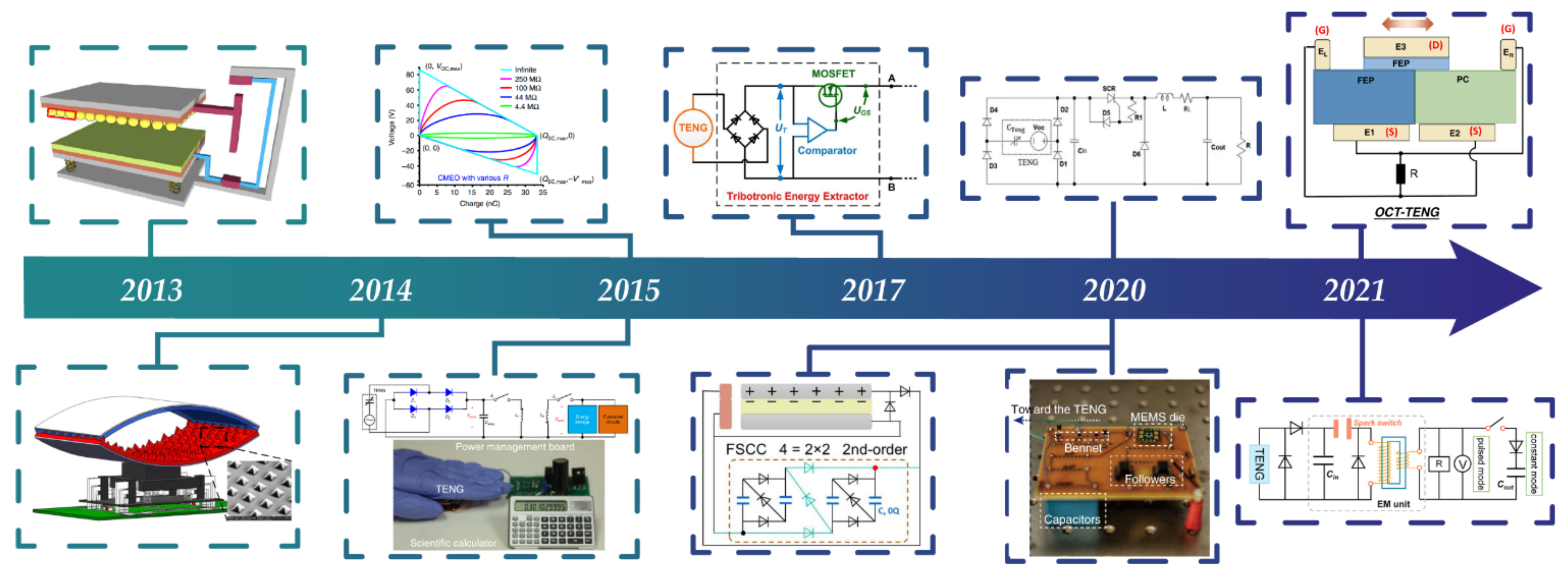
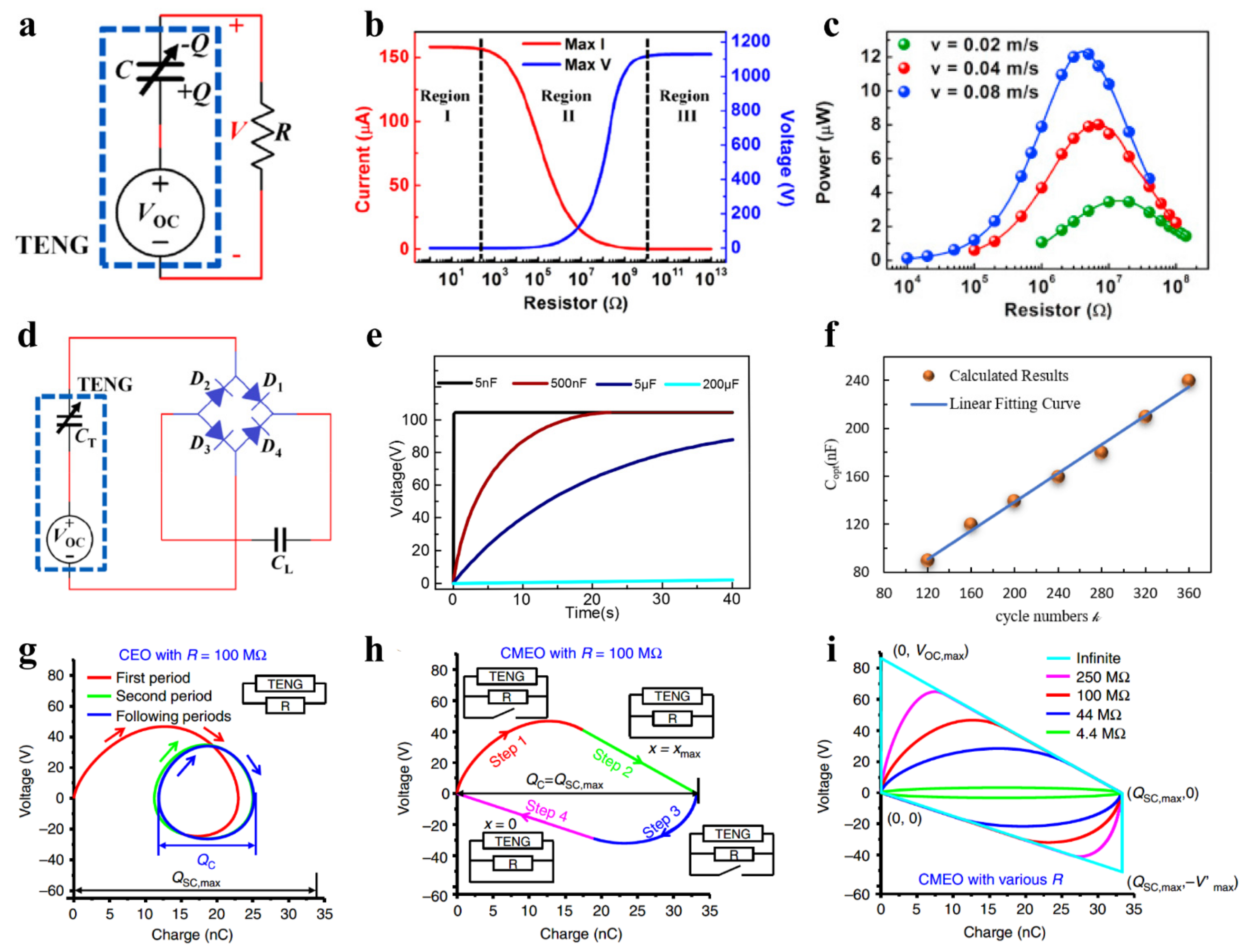
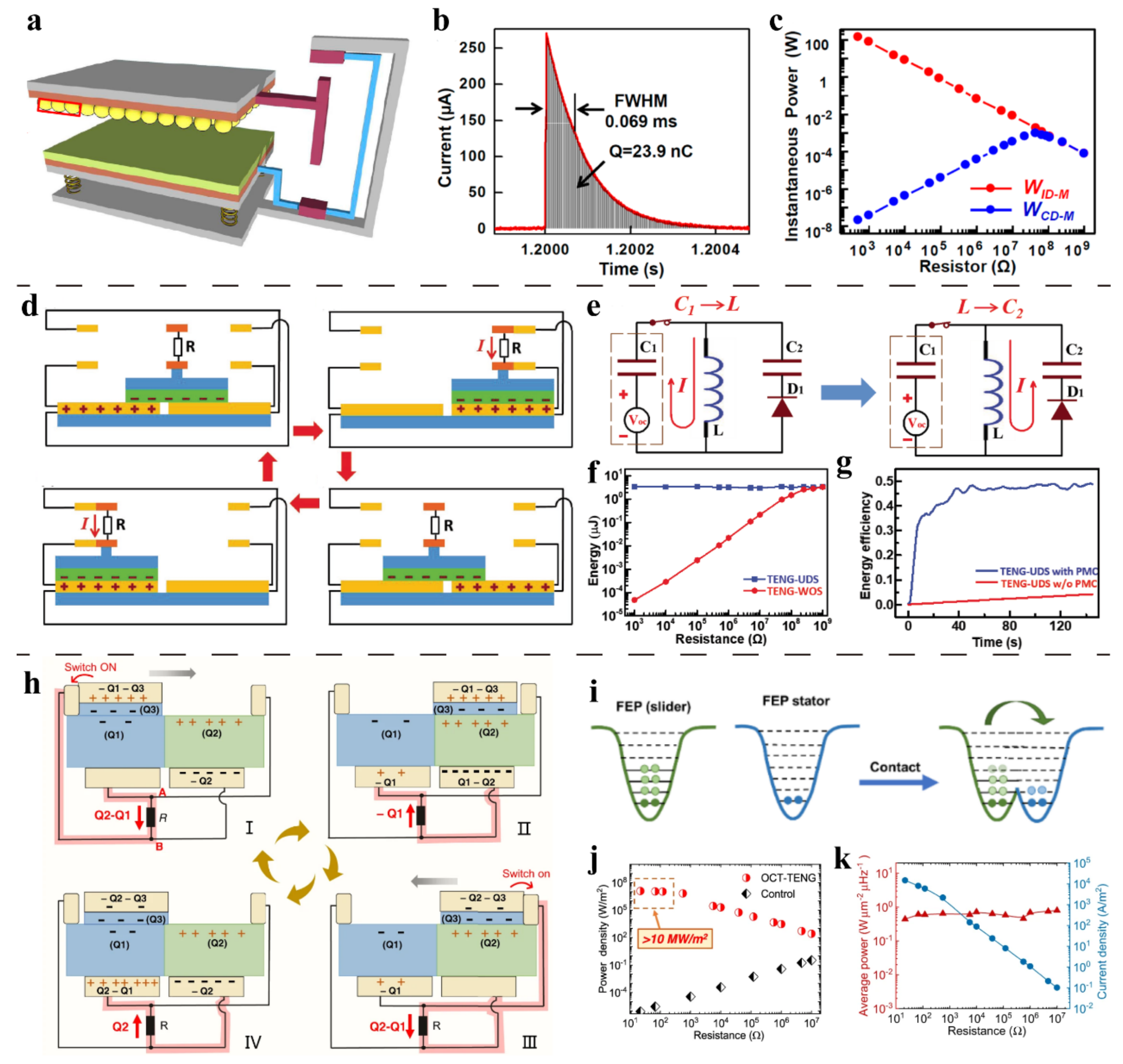
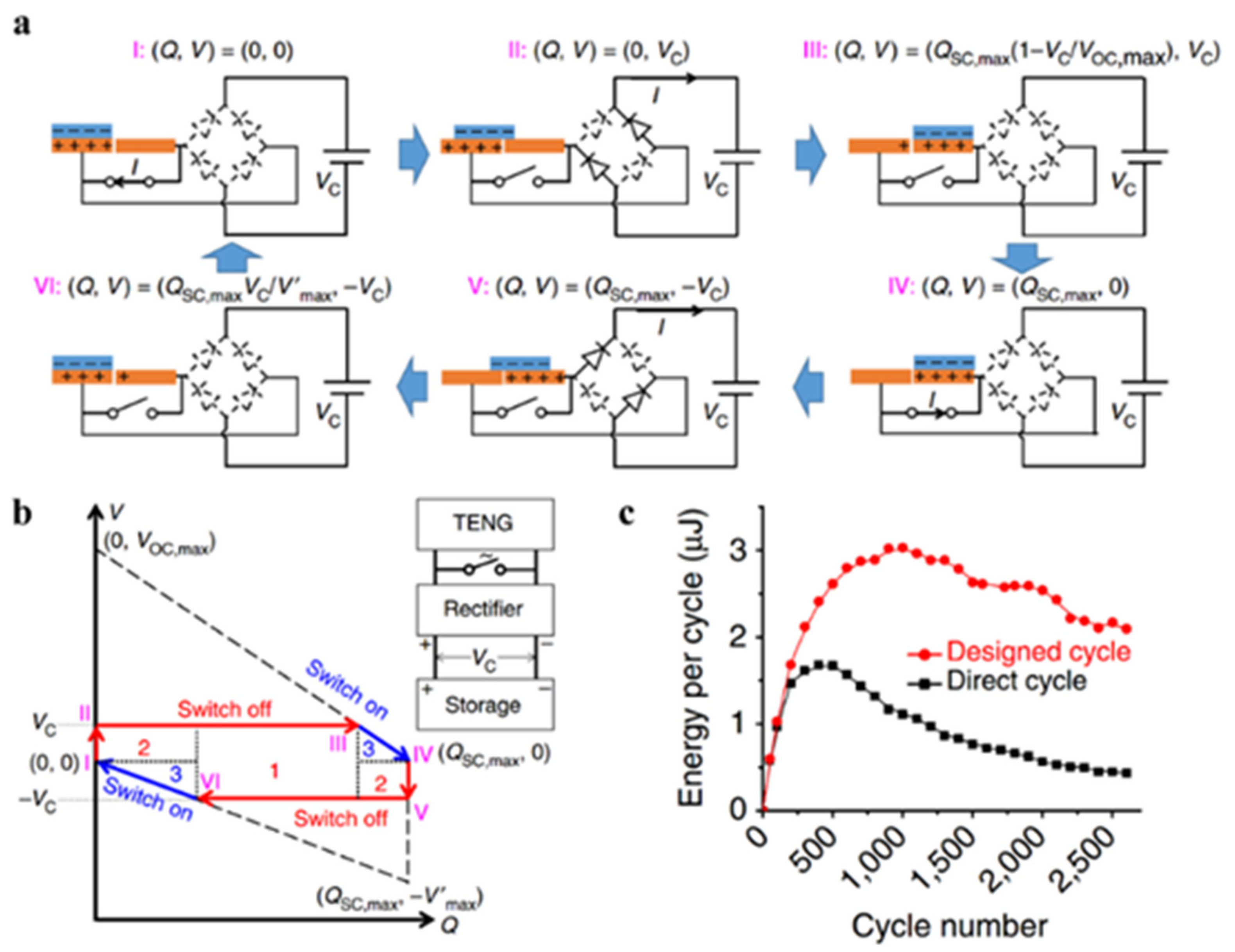
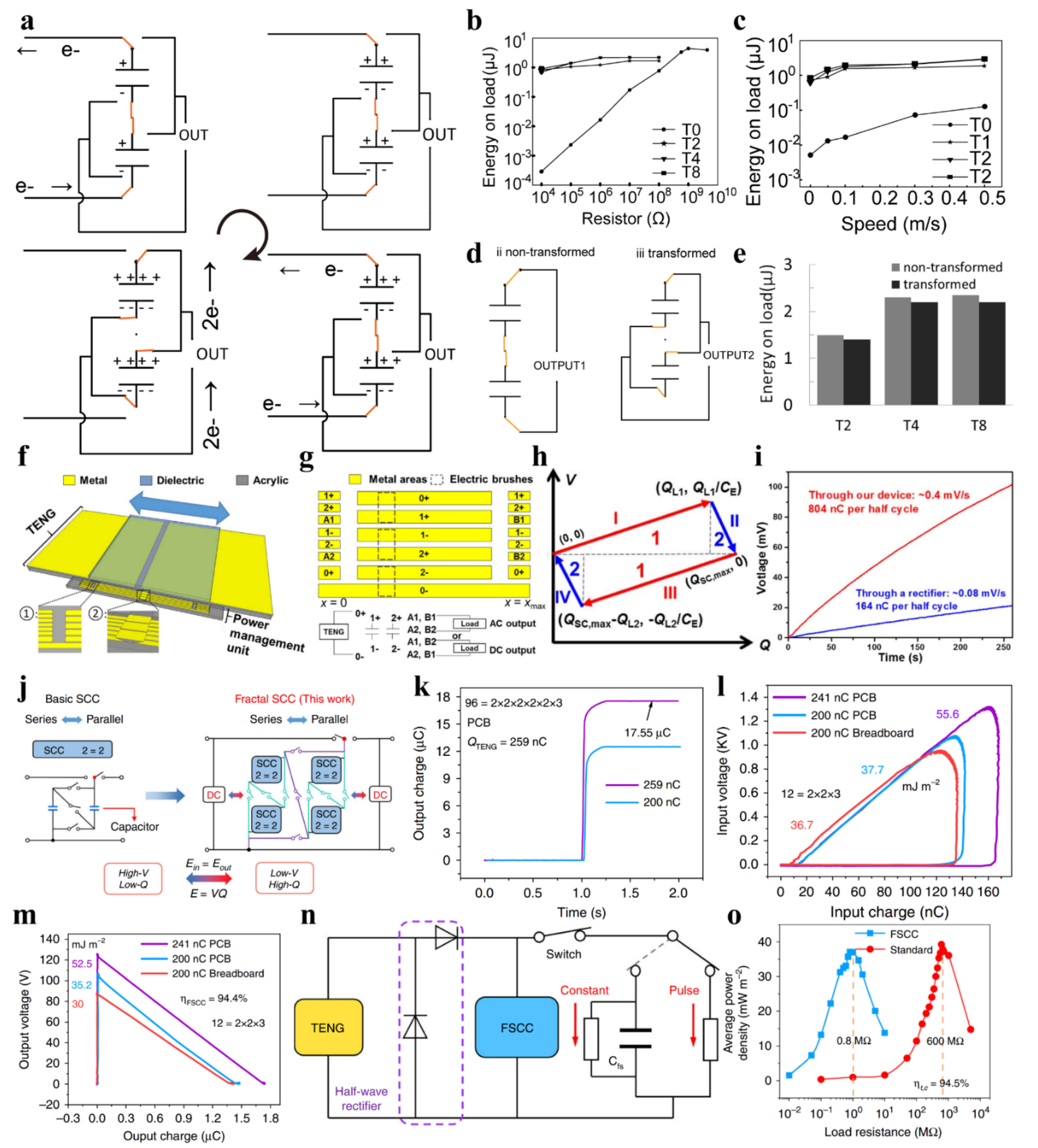
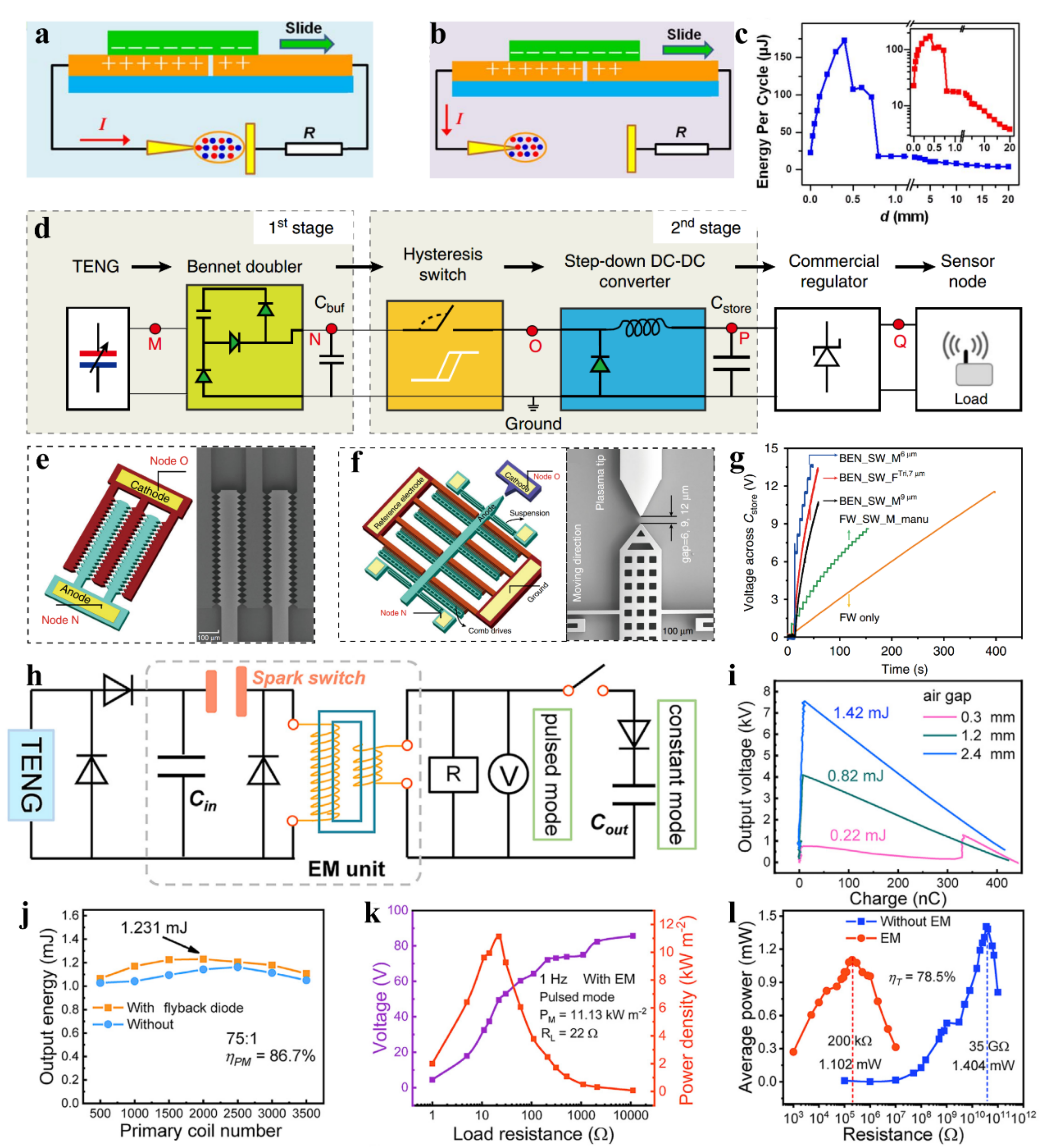
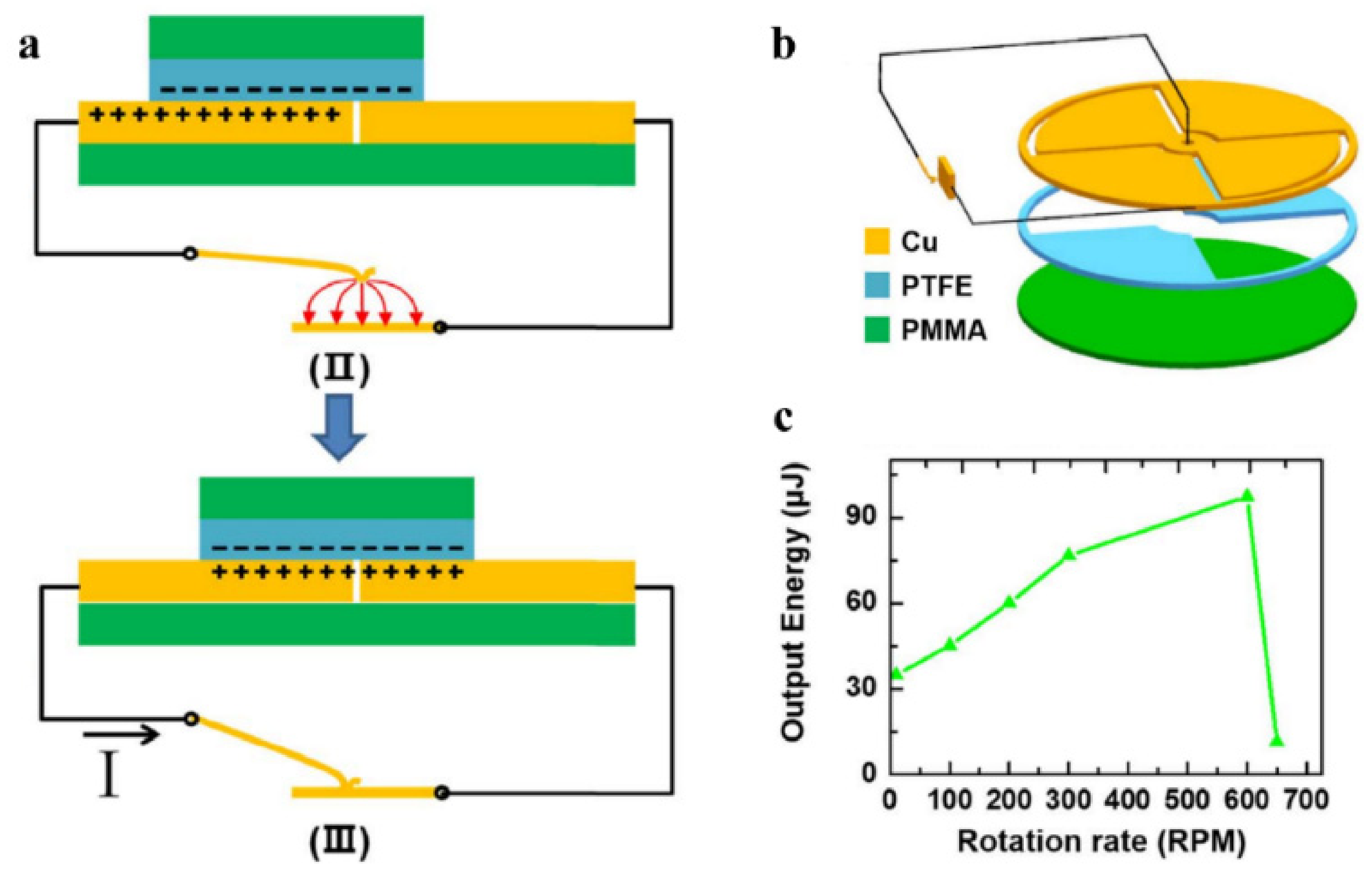
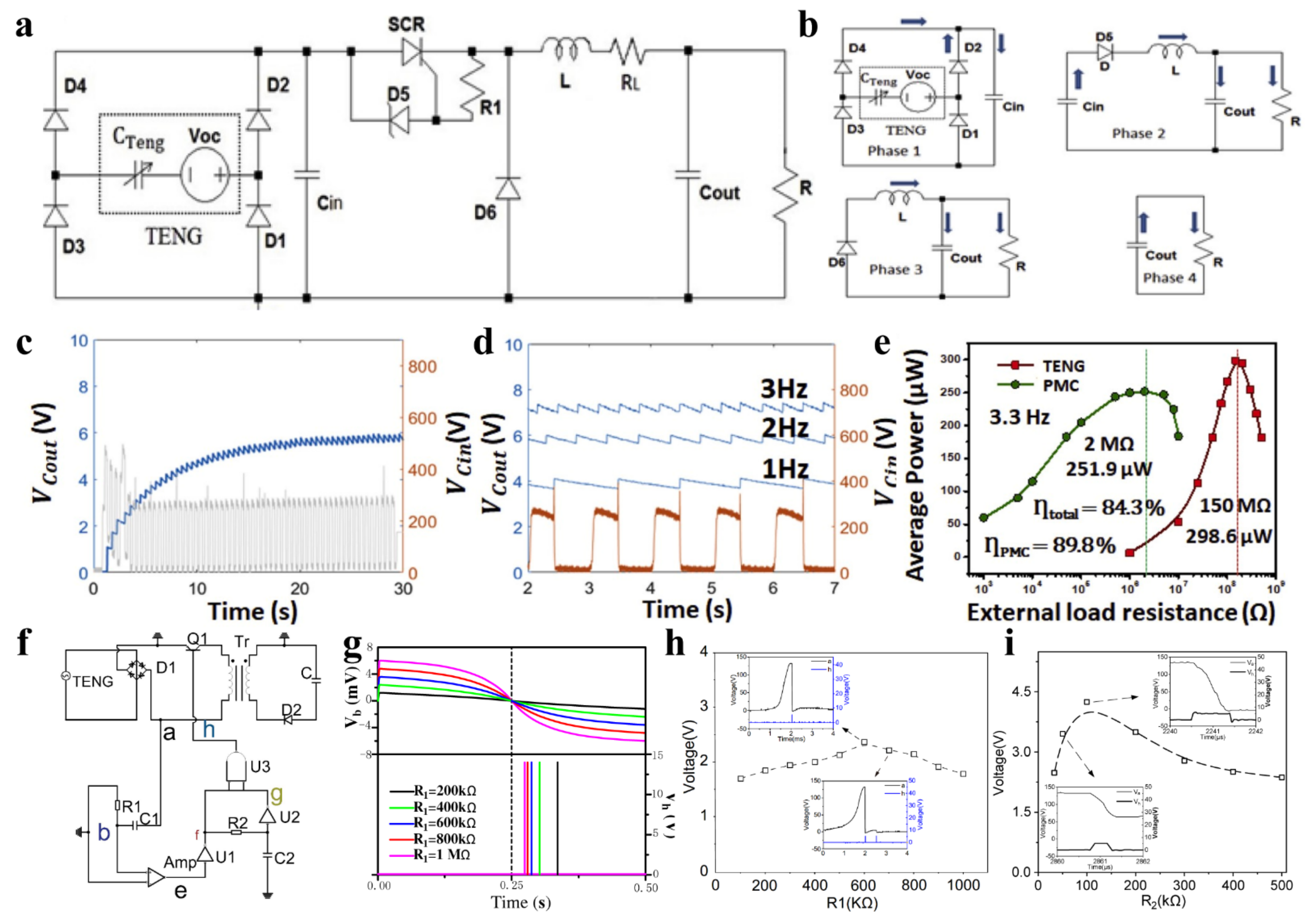
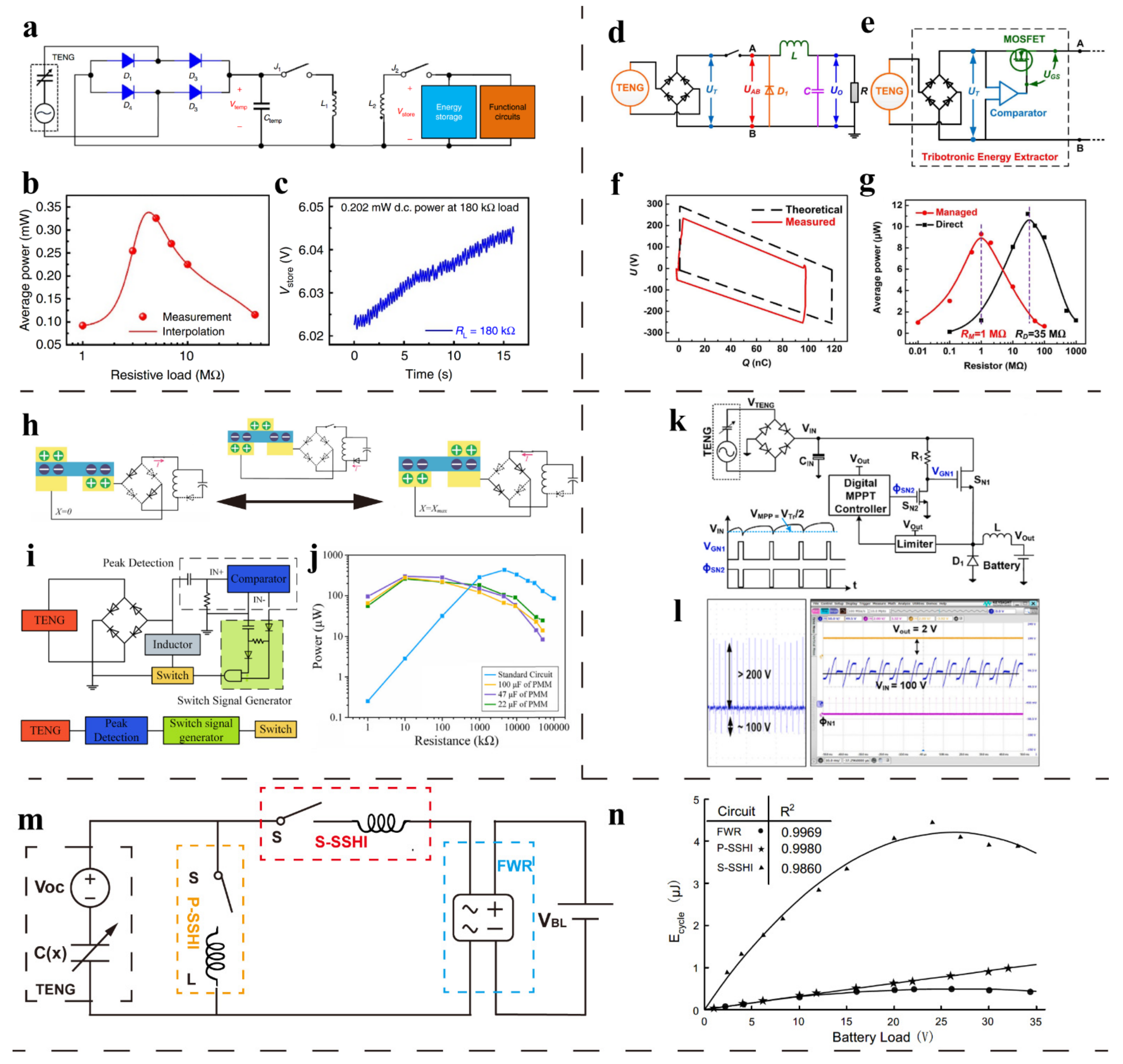
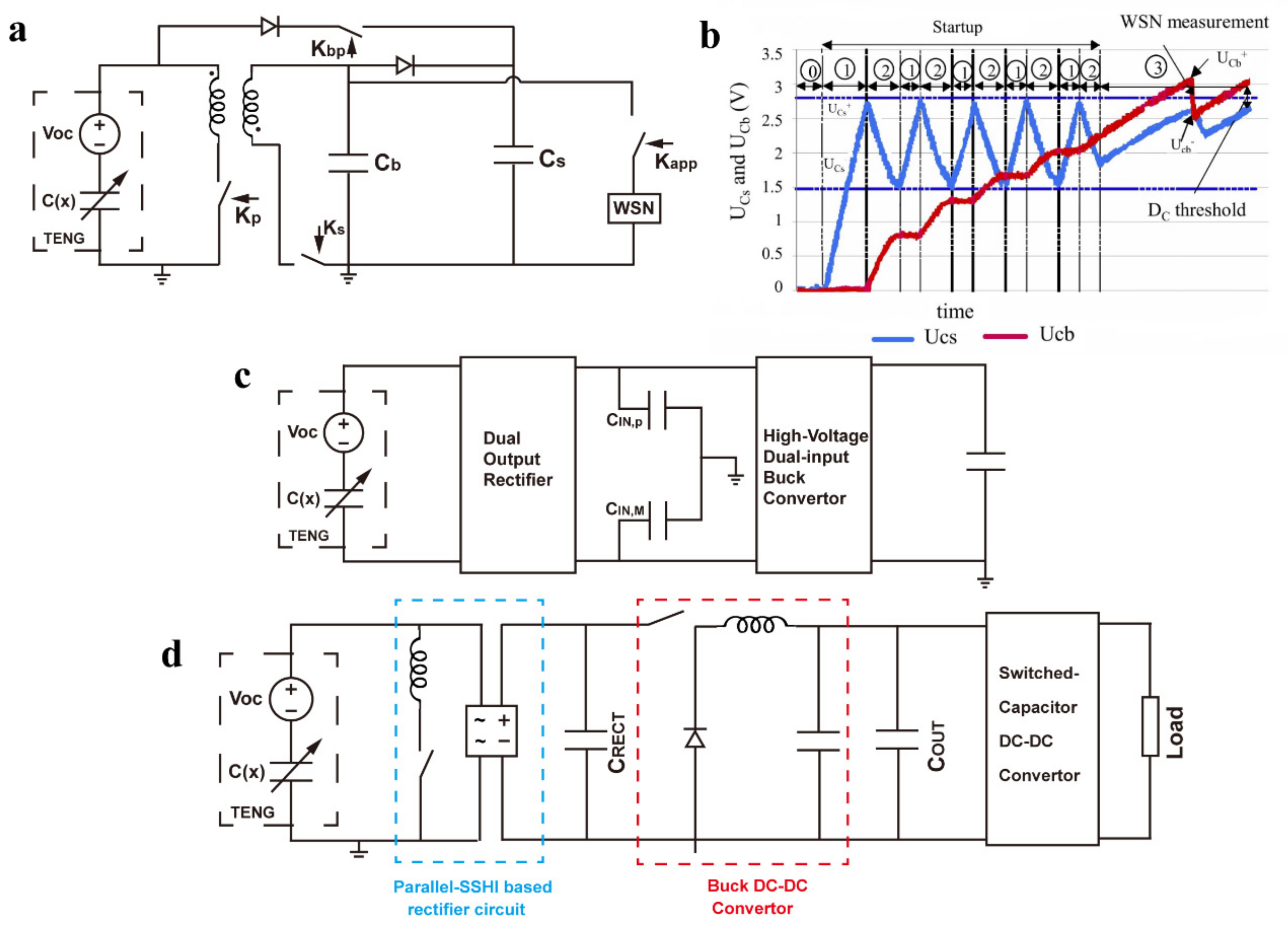
Publisher’s Note: MDPI stays neutral with regard to jurisdictional claims in published maps and institutional affiliations. |
© 2022 by the authors. Licensee MDPI, Basel, Switzerland. This article is an open access article distributed under the terms and conditions of the Creative Commons Attribution (CC BY) license (https://creativecommons.org/licenses/by/4.0/).
Share and Cite
Zhou, H.; Liu, G.; Zeng, J.; Dai, Y.; Zhou, W.; Xiao, C.; Dang, T.; Yu, W.; Chen, Y.; Zhang, C. Recent Progress of Switching Power Management for Triboelectric Nanogenerators. Sensors 2022, 22, 1668. https://doi.org/10.3390/s22041668
Zhou H, Liu G, Zeng J, Dai Y, Zhou W, Xiao C, Dang T, Yu W, Chen Y, Zhang C. Recent Progress of Switching Power Management for Triboelectric Nanogenerators. Sensors. 2022; 22(4):1668. https://doi.org/10.3390/s22041668
Chicago/Turabian StyleZhou, Han, Guoxu Liu, Jianhua Zeng, Yiming Dai, Weilin Zhou, Chongyong Xiao, Tianrui Dang, Wenbo Yu, Yuanfen Chen, and Chi Zhang. 2022. "Recent Progress of Switching Power Management for Triboelectric Nanogenerators" Sensors 22, no. 4: 1668. https://doi.org/10.3390/s22041668
APA StyleZhou, H., Liu, G., Zeng, J., Dai, Y., Zhou, W., Xiao, C., Dang, T., Yu, W., Chen, Y., & Zhang, C. (2022). Recent Progress of Switching Power Management for Triboelectric Nanogenerators. Sensors, 22(4), 1668. https://doi.org/10.3390/s22041668






